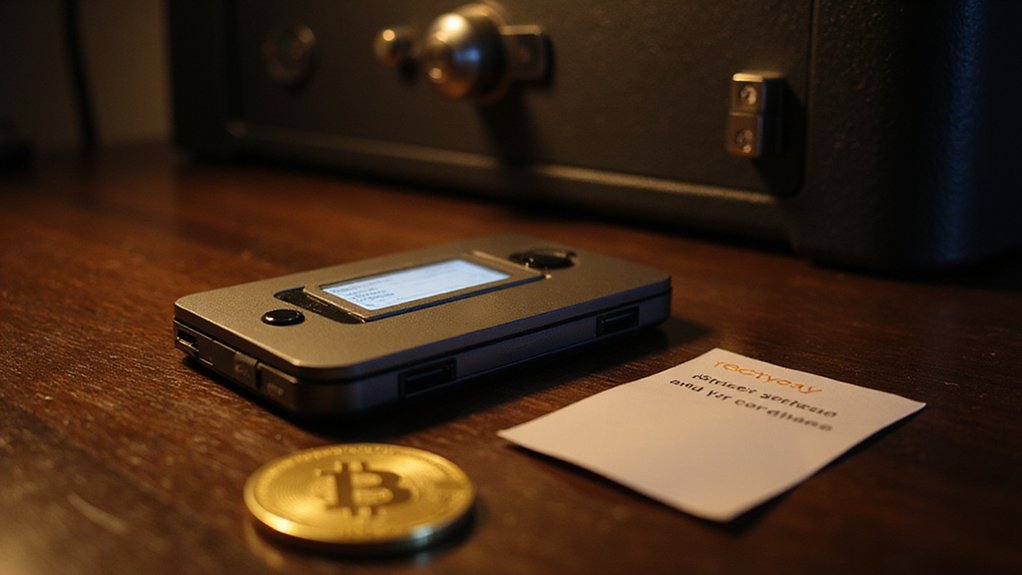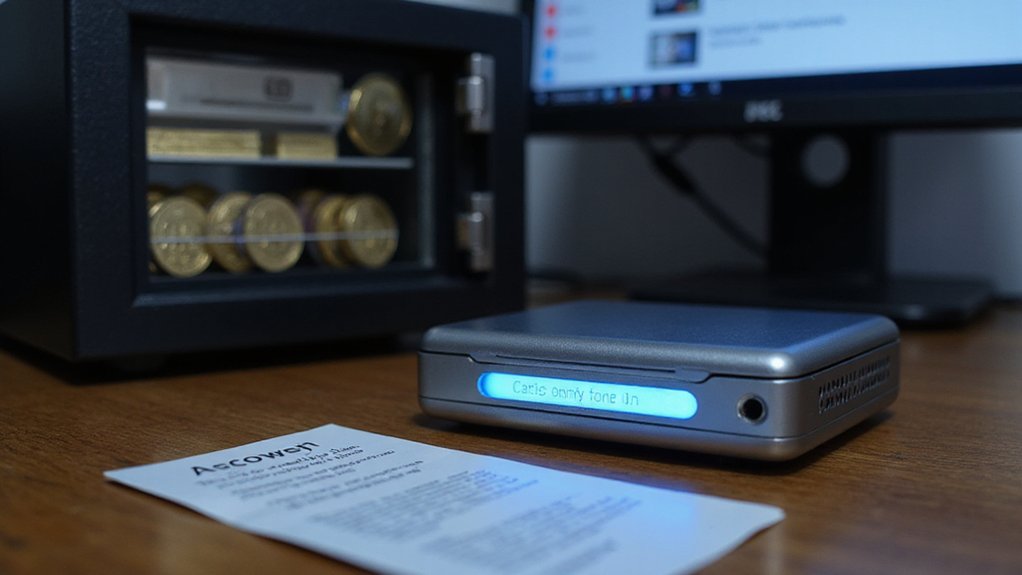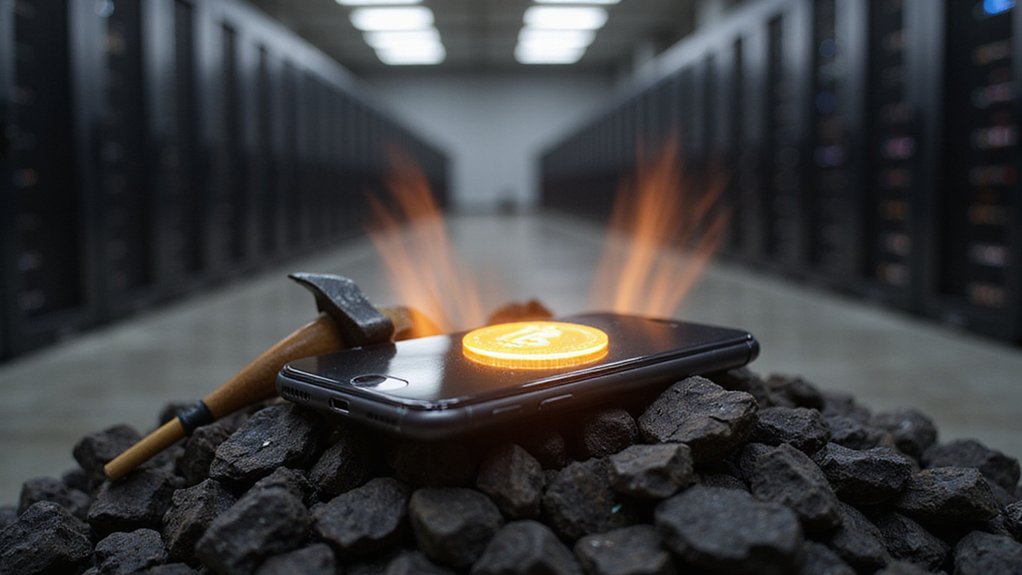Storing bitcoins safely demands a strategic balance between security and accessibility—that elusive Goldilocks zone of crypto custody. Cold storage options (hardware wallets like Ledger or Trezor) protect long-term holdings by keeping private keys entirely offline, while hot wallets provide convenient access for regular transactions, albeit with elevated risk exposure. Prudent investors adopt a hybrid approach: cold storage for significant holdings, hot wallets for expendable amounts, and non-negotiable backup protocols for recovery seeds. The nuances of custodial versus self-custody arrangements warrant further examination.

The quest for secure bitcoin storage represents perhaps the most consequential decision cryptocurrency investors face—one that balances the ever-present tension between accessibility and security. Bitcoin holders navigate a spectrum of options, each with its own risk profile that correlates, somewhat predictably, with convenience.
The sophisticated investor understands that security and accessibility exist in inverse proportion to one another—a relationship that manifests in the fundamental distinction between “hot” and “cold” storage methods.
The greater the security, the less accessible your bitcoin; the more accessible, the greater your vulnerability.
Cold storage wallets—the financial equivalent of burying treasure—store private keys entirely offline, beyond the reach of even the most determined digital pirates. Statistics indicate that approximately 60% of Bitcoin is held in long-term storage, highlighting the preference for security over immediate accessibility.
Hardware wallets from manufacturers like Ledger and Trezor (priced between $40-$200) have emerged as the gold standard for serious holders, offering offline key management with recovery seed backup options. These physical devices require actual, tangible presence to sign transactions—a quaint notion in our increasingly virtualized financial landscape. Hardware wallets enhance security by ensuring private keys never leave the device during transaction signing, creating an impenetrable barrier against remote attacks.
In contrast, hot wallets maintain continuous internet connectivity, offering the convenience modern users expect while simultaneously exposing themselves to the full panorama of online threats. These software implementations (think MetaMask or Coinbase Wallet) facilitate seamless integration with decentralized finance applications and support hundreds of thousands of tokens. Their accessibility comes at a price, however—one potentially measured in lost assets.
Best practices suggest a hybrid approach: cold storage for substantial, long-term holdings complemented by hot wallets containing only amounts one can afford to lose.
Regular offline backups of recovery seeds (stored in multiple secure locations), robust password hygiene, and two-factor authentication represent minimum security standards. Users must also consider their technical proficiency and frequency of transactions when selecting wallet types.
The custodial versus non-custodial distinction introduces another layer of complexity. While exchange-held wallets eliminate the responsibility of key management, they substitute counterparty risk—a trade reminiscent of traditional banking relationships.
Non-custodial solutions preserve the “not your keys, not your coins” ethos that attracted many to cryptocurrency initially, but demand greater personal responsibility.
Many experts evaluate wallets based on over 15 factors including security features, supported cryptocurrencies, and ease of conversion between hot and cold storage options.
Frequently Asked Questions
How Do I Recover Bitcoins if My Hardware Wallet Is Lost?
Recovering bitcoins after losing a hardware wallet hinges entirely on the recovery seed phrase—those 12-24 words initially generated during setup.
Users must locate this offline backup and import it into a new compatible wallet (hardware or software).
Without this cryptographic lifeline, funds remain frustratingly inaccessible; the blockchain’s immutability, while revolutionary for financial sovereignty, offers no forgiveness for misplaced keys.
The process simply requires selecting “restore wallet” and entering the seed phrase sequentially.
Can I Insure My Bitcoin Holdings Against Theft?
Yes, Bitcoin holdings can be insured against theft, though options remain more robust for institutional players than retail hodlers.
Several providers—Canopius, Evertas, and Breach Insurance among them—offer policies covering criminal activities like hacking and employee theft.
Coverage typically excludes market volatility (naturally) and requires adherence to stringent security protocols.
Premiums vary based on storage methods, with cold storage commanding more favorable rates than hot wallets, which insurers view (quite reasonably) with greater skepticism.
Are Paper Wallets Still Considered Secure in 2023?
Paper wallets, while still theoretically secure in 2023 given their offline nature, have largely fallen out of favor among cryptocurrency experts.
The manual process—fraught with potential for human error during creation, storage, and redemption—now presents more risk than reward.
Modern alternatives like hardware wallets offer comparable security benefits without the fragility concerns.
Additionally, innovations in seed phrases and multi-signature solutions have rendered the once-vaunted paper wallet approach somewhat archaic, if not dangerously simplistic by current standards.
How Often Should I Update My Wallet Software?
Wallet software update frequency varies by type: hot wallets demand monthly vigilance (the price of convenience, alas), while cold storage solutions require quarterly attention at minimum.
Most reputable developers release major versions semi-annually, with security patches appearing as needed—ignoring these is financial Russian roulette.
Users should subscribe to official channels and heed update notifications immediately, particularly following regulatory shifts or when blockchain upgrades loom on the horizon.
The crypto-fastidious check weekly.
What Happens to My Bitcoins if I Die?
Without a proper inheritance plan, bitcoins can become permanently inaccessible upon death—a digital-age financial tragedy.
Bitcoins must be explicitly mentioned in wills or trusts, with beneficiaries requiring access to private keys.
Inheritance follows standard estate processes, subject to probate, taxes, and creditor claims.
Estate planning options include custodial services, collaborative custody arrangements, or detailed instructions for self-custody transfer.
Jurisdictional variations in intestacy laws further complicate matters, making professional legal guidance practically mandatory for substantial holdings.









